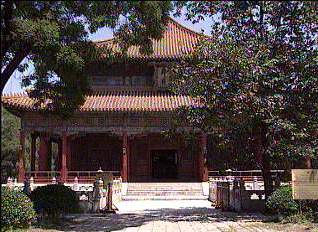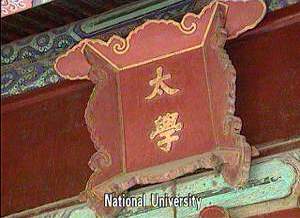 |
|
Imperial College  |
| CCTV.COM 2002-03-20 11:03:48 |
|
 There is a Guozijian Street at Andingmennei of Beijing. It is the street that has more archways or pailou than any other street in Beijing and it emanates strong cultural atmosphere. "Guozijian", or Imperial College of Beijing, the highest educational institution of the Yuan, Ming and Qing dynasties, situates in this street. In modern term, the Imperial College is a national institution of higher learning in the capital. There is a Guozijian Street at Andingmennei of Beijing. It is the street that has more archways or pailou than any other street in Beijing and it emanates strong cultural atmosphere. "Guozijian", or Imperial College of Beijing, the highest educational institution of the Yuan, Ming and Qing dynasties, situates in this street. In modern term, the Imperial College is a national institution of higher learning in the capital.
Strictly speaking, the highest state educational institute in ancient China began with the "Taixue" or National University in the Han Dynasty. In the Sui Dynasty it was changed to Imperial College. During the Tang and Song dynasties, the National University and Imperial College coalesced. In the Yuan, Ming and Qing dynasties, only Imperial College remained.
Today's large Imperial College in Beijing underwent reconstruction in the Yuan, Ming and Qing dynasties. The central building in it is called "piyong", meaning the circular pool. Its name came from the national university called piyong established by the supreme rulers of the Western Zhou Dynasty.
The piyong in the Imperial College was a place where the emperor gave lectures. In the Qing Dynasty emperors Qianlong, Daoguang and Xianfeng gave lectures here.
It's said after the construction of the piyong, Emperor Qianlong came in person to supervise the instruction. That day all ministers and students in the capital city stood in lines to welcome the emperor and more than three thousand people attended the lecture.
In the Ming and Qing dynasties, the Imperial College was a place to train functionaries for the state. So the instructors were selected according to strict criteria. For example, instructors like Song Ne, Li Shimian, Song Lian in the Ming Dynasty, and Ji Yun and Wang Yirong in the Qing Dynasty were all famous writers or scholars.
 The students in the Imperial College studied three or four years. Their classrooms were named according to the years they had studied in the Imperial College. After graduation, they could directly go to government institutions at different levels, or alternatively, pass the national imperial examination and become jinshi, and then be appointed to different official posts by the emperor. The students in the Imperial College studied three or four years. Their classrooms were named according to the years they had studied in the Imperial College. After graduation, they could directly go to government institutions at different levels, or alternatively, pass the national imperial examination and become jinshi, and then be appointed to different official posts by the emperor.
To the east of the Imperial College is the Confucius Temple, which is an integral part of the Imperial College. From the central to local levels, all state schools had a Confucius Temple at its left, namely, east.
From the tablets bearing names of jinshi, namely those who had passed the national imperial examination, we can find some familiar names, like the Ming-dynasty scientist Xu Guangqi, the Qing-dynasty Minister of Personnel Liu Yong, the Grand Minister of State Wen Tonghe, the thinker and writer Gong Zizhen, and the vice chairman of the National People's Congress of the People's Republic of China, Shen Junru.
As the Western progressive culture and education system were introduced into China, the first new style school the Institute of Diplomatic Relations was founded in 1862. China's first modern national university Metropolitan University was established in 1898. In 1905 the Qing government abolished the system of imperial examinations, closed the Imperial College, and established the Education Ministry. The Imperial College quitted the history. After the establishment of the People's Republic of China, the site of former Imperial College became the Capital Library and the site of Confucius Temple, National Museum. They still play their part in disseminating Chinese culture.
|
|
|
|
|
|
|
 |









